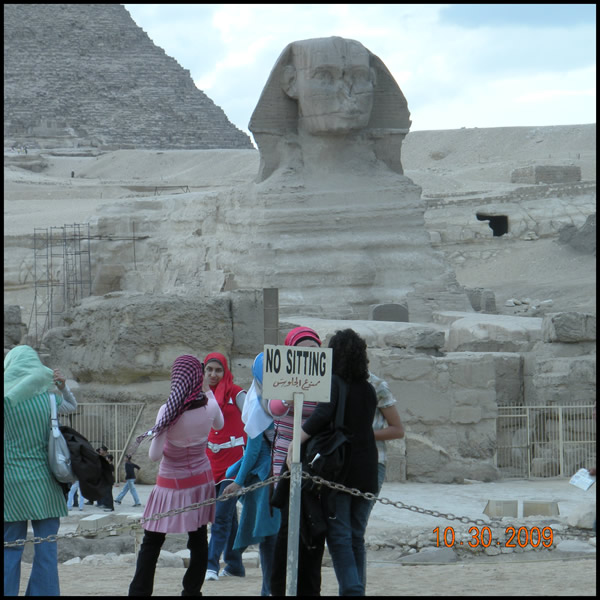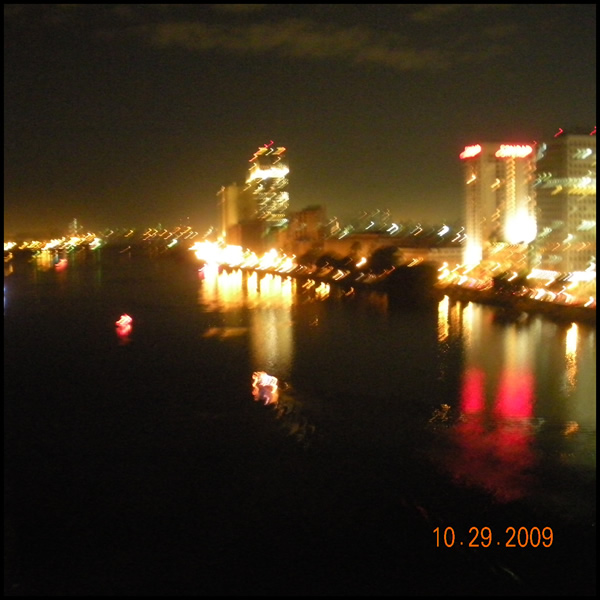Sunday 22 November 2009
It seems that I’m in Cairo more often than Alexandria these days and that impression is not without justification. I have been here every weekend for the past three and will be down this way again next weekend. The train conductors and I are on a first-name basis, practically.
Friday afternoon, I took the train from Alexandria and arrived about 5:30 in the afternoon. I had made arrangements to stay with my Fulbright colleague Scott Hibbard, a professor of International Relations at DePaul University in Chicago, and once we arrived in Cairo, I made my way by the Metro underground to his apartment in a section of Cairo called Sakanat al-Ma`adi. Ma`adi is a rather “tony” part of town built a century ago by the British for their civil servants who were running Egypt at the time. The streets are tree-lined and shady and there are some impressive digs—single family homes—as well as nice restaurants and up scale apartments. Scott met me at the Metro station and as we walked from the train station to his apartment in the gathering dark, he gave me a quick orientation to his neighborhood. Many of the apartments and a few of the homes were the property of the American University in Cairo and are made available to their foreign faculty and administrators. Scott’s place was on the fourth floor of a modern building, big and airy. Marble tile floors, a raised dining area and a big modern kitchen. Floor to ceiling windows looked out to the east.
I dropped my bags and we headed out to eat dinner with Glen, a colleague of Scott’s at AUC. We enjoyed dining outside under a pergola of sorts; the weather is still mild enough for that sort of activity although a sweater or long-sleeve shirt is not a bad idea. The restaurant was rather busy for two reasons. Friday is the equivalent of Saturday night in the States; people kick back and take some time out wherever they are. Second, Ma`adi is a Cairo destination of sorts for relaxation.I was glad we were outside because ther were many people about smoking “shisha,” the water pipes filled with scented tobacco and kept alight with chunks of charcoal placed on top of the tobacco. The gurgling sound they made created a rather calming white noise.
There are tons of restaurants in Ma`adi, and people of middle class means have their favorite places here. There are also shops and pubs which attract both Egyptians and the sizeable expatriate population of this district. After the customary appetizers of hummus and falafel, I ordered an Egyptian specialty called “kushari,” which is a mixture of rice, thin pasta noodles, nuts, and a tomato based sauce. As with most national dishes, every household and every restaurant will claim that theirs is the most authentic. Who cares? The informal competition leads to interesting culinary developments. This restaurant’s version was quite tasty, a little on the spicy side but piquant rather than hot. We finished with a dessert called “Umm `Ali,” a sort of cream pudding with nuts, raisins, and other goodies. I had wanted to try this dish for a long time and this was worth the wait.
We drank tea while we digested a bit, talked about Egypt and what we were experiencing living and working as foreigners. Glen, who looks to be making a career out of teaching here is quite comfortable with his limited Arabic and enjoys living in Egypt. Like me, Scott is enjoying the feeling of being spoiled—the big apartment, the healthy salary, the semi-star treatment from the Fulbright folks. Makes going home hard to do…
After dinner, Glen went off to met some friends in a pub, but Scoot and I headed home and bed; we’re off early tomorrow for a trip into the desert.
Our alarms went off at ten to six and we rolled out of bed, got dressed and had a quick cup of coffee. Breakfast was unnecessary since the Fulbright office was providing breakfast boxes for us to take along on the first leg of our trip. We grabbed a cab for what turned out to be a twenty-minute ride to Dokki and the Fulbright office arriving at the rendezvous well before the appointed hour of seven AM. There were a couple of other early risers there and we chatted while the rest of the group trickled in. At about quarter to eight, we picked up our breakfast boxes and walked to the corner where eight Land Cruisers were waiting for us. Each bore a number and we were told to remember which one was ours; we couldn’t trade vehicles once we started because the number system assured that no one would be left behind. I was in vehicle #2, driven by Sharif, “one of our best drivers,” according to the expedition leader. I wondered who got the less qualified drivers.
 We set off through Cairo traffic, which was beginning to build at that hour. It took us a good hour to clear Cairo and then we were on the four-lane headed south toward the Fayyoum. I had ridden this same road earlier in the month when I visited Karanis so I busied myself with breakfast and chatting with my travel mates: Virginia da Costa, Dominique Ellis, Breonna Arder, and Joe Yackley, our newest member who is pursuing dissertation research in Egypt and Turkey later on. The Toyota we were in was not the newest ride on the road and had obviously seen some rough cross country travel. The suspension was stiff and that, combined with a short wheel base, made for a rough journey, even on the paved road. To add to our discomfort, Dominique and Breonna, who had chosen to ride in the rear seats, had to deal with gasoline fumes. For this reason as well as to give people different conversation partners, we switched seats occasionally.
We set off through Cairo traffic, which was beginning to build at that hour. It took us a good hour to clear Cairo and then we were on the four-lane headed south toward the Fayyoum. I had ridden this same road earlier in the month when I visited Karanis so I busied myself with breakfast and chatting with my travel mates: Virginia da Costa, Dominique Ellis, Breonna Arder, and Joe Yackley, our newest member who is pursuing dissertation research in Egypt and Turkey later on. The Toyota we were in was not the newest ride on the road and had obviously seen some rough cross country travel. The suspension was stiff and that, combined with a short wheel base, made for a rough journey, even on the paved road. To add to our discomfort, Dominique and Breonna, who had chosen to ride in the rear seats, had to deal with gasoline fumes. For this reason as well as to give people different conversation partners, we switched seats occasionally.
 Before long, we were nearing the turnoff for the Fayyoum oasis. I saw the Karanis excavation off to the left of the road and knew we were getting near. What came next surprised me greatly. I knew that the Nile branched off near the Fayyoum and that a lake (Lake Faroun) was formed as a result; I also knew that the lake had no outlet. The waters contained in it simply evaporate or are drawn off for agriculture. What I didn’t realize was how HUGE this lake was. We drove along one side of the lake for a good forty minutes, at speed, and still didn’t reach the end. It is a good fifty kilometers (i.e. about 30 miles) long and ten to fifteen wide. Major oasis! There were numerous fishing boats out and about and fishermen mending nets along the shore. Whitecaps dotted the surface of the lake and the boats—most of which were oar powered—bobbed across the swells.
Before long, we were nearing the turnoff for the Fayyoum oasis. I saw the Karanis excavation off to the left of the road and knew we were getting near. What came next surprised me greatly. I knew that the Nile branched off near the Fayyoum and that a lake (Lake Faroun) was formed as a result; I also knew that the lake had no outlet. The waters contained in it simply evaporate or are drawn off for agriculture. What I didn’t realize was how HUGE this lake was. We drove along one side of the lake for a good forty minutes, at speed, and still didn’t reach the end. It is a good fifty kilometers (i.e. about 30 miles) long and ten to fifteen wide. Major oasis! There were numerous fishing boats out and about and fishermen mending nets along the shore. Whitecaps dotted the surface of the lake and the boats—most of which were oar powered—bobbed across the swells.
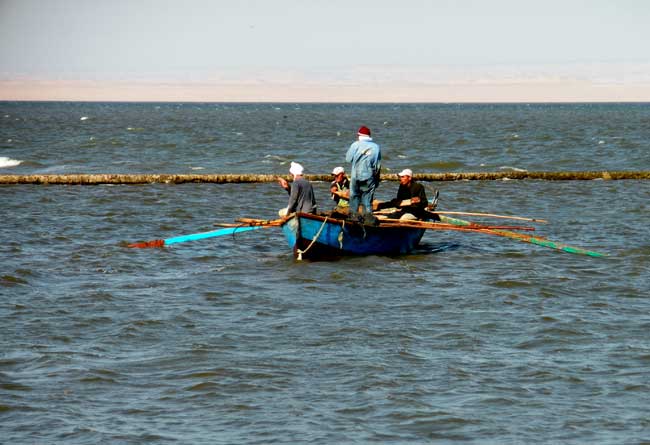
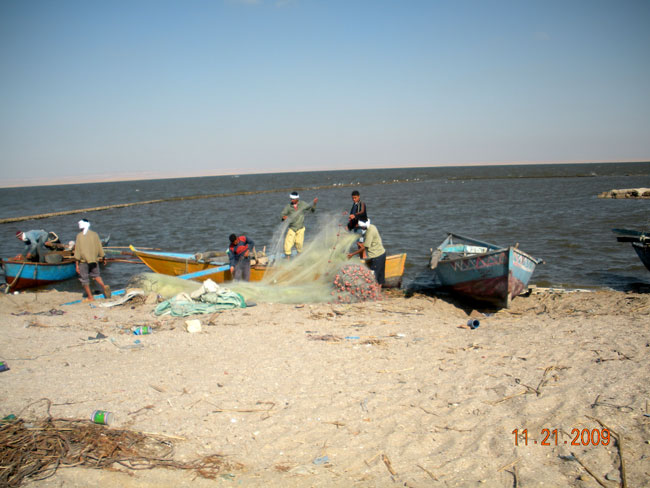
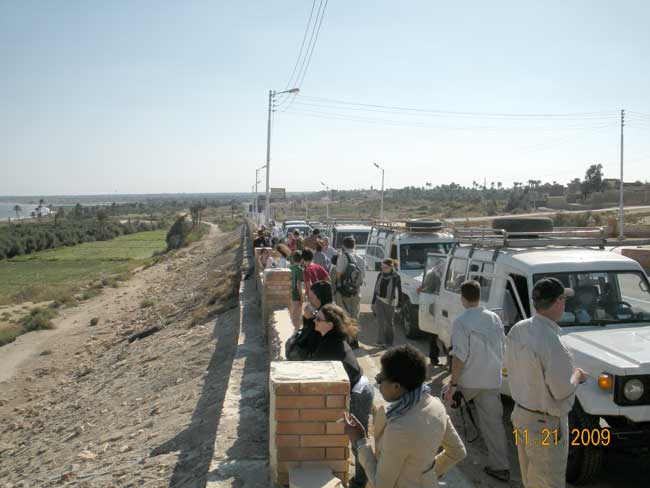 We made a brief stop so that people could take photos and then continued our journey. Our destination was an archeological excavation in a geographical feature called Wadi al-Hitan or the Valley of the Whales. Yes, in the desert, there is a place where one can see what’s left of whales. Of course they are forty-million-year-old whales but they are (or were) whales. One species in particular, the Basilosaurus, is found only here and its importance to paleontologists and those who study evolution lies in the fact that they had vestigial feet. In other words, whales were once land dwellers who decided that the ocean offered a better living and returned to the primordial soup as it were.
We made a brief stop so that people could take photos and then continued our journey. Our destination was an archeological excavation in a geographical feature called Wadi al-Hitan or the Valley of the Whales. Yes, in the desert, there is a place where one can see what’s left of whales. Of course they are forty-million-year-old whales but they are (or were) whales. One species in particular, the Basilosaurus, is found only here and its importance to paleontologists and those who study evolution lies in the fact that they had vestigial feet. In other words, whales were once land dwellers who decided that the ocean offered a better living and returned to the primordial soup as it were.
We took off again, eight four wheelers flying south down a two-lane blacktop road toward an area known as Wadi al-Rayan, which is a huge area and contains a number of prehistoric sites as well as ruins of ancient settlements. For nearly half an hour, we traveled along another body of water (actually two, I later found out), climbing above it before turning west and leaving the lake and pavement behind. At this point we saw a stone marker with a sign stating that we were entering a World Heritage Site. The site was established in 1989 and seeks to preserve a unique geological area covering some 600 square miles. It was within this area that an intrepid Brit set out to do some exploring in the 1920s and discovered the first fossilized skeletal remains of the ancient whales. Since that time, over one thousand skeletons of three different whale species have been unearthed here. By now, we were in the real desert. No trees, no green, just rock and sand, the road a graded but unpaved track. The Land Rovers pounded along at speed, dust billowing up behind us in thick clouds and the rough surface loosening our teeth. Conversation above the cacophony of rattles was impossible so we simply stared out the windows as the scenery whizzed past.
 We arrived at the visitors’ center and alighted from the trucks. We walked about for a few minutes to work the kinks out and take in the landscape. The area reminded me of the desert southwest in the States, but without the variety of colors. Still, the rock formations were impressive, having been sculpted by the sand and the wind over untold millennia. We gathered at one of the buildings and received a brief orientation from the head paleontologist who explained the geology of the region and the importance of the site. He explained that there were there distinct geological layers found here representing a cross-section of several tens of millions of years. Whales continued to live here during all of that time until the Earth’s climate began to cool and the polar ice caps formed, pulling liquid water away from the planet’s girth. Now it looks as though we’re reversing course once again. The paleontologist also showed us some fossilized remains of the whales and explained how they came to be preserved. The remains were covered quickly by silt or sand and the soft tissues decayed quickly. That allowed the minerals in the water and earth to replace the organic material of the skeletons and fossilize them.
We arrived at the visitors’ center and alighted from the trucks. We walked about for a few minutes to work the kinks out and take in the landscape. The area reminded me of the desert southwest in the States, but without the variety of colors. Still, the rock formations were impressive, having been sculpted by the sand and the wind over untold millennia. We gathered at one of the buildings and received a brief orientation from the head paleontologist who explained the geology of the region and the importance of the site. He explained that there were there distinct geological layers found here representing a cross-section of several tens of millions of years. Whales continued to live here during all of that time until the Earth’s climate began to cool and the polar ice caps formed, pulling liquid water away from the planet’s girth. Now it looks as though we’re reversing course once again. The paleontologist also showed us some fossilized remains of the whales and explained how they came to be preserved. The remains were covered quickly by silt or sand and the soft tissues decayed quickly. That allowed the minerals in the water and earth to replace the organic material of the skeletons and fossilize them.
 The paleontologist soon led us off on a tour of the area. The path through the site was marked by stones and clay pots. At various locations, examples of the skeletons were on display. Some of the exhibits were clearly staged and the scientist acknowledged this. He said that one species in particular had a tendency to curl in death—probably due to contractions in the heavy muscles—and the scientists had straightened out the display skeletons so that people could get a clearer idea of the scale and composition of the bones. The exhibits are scattered over quite a wide area and an hour’s walk didn’t bring us anywhere near the end of the trail. In addition to animal fossils, there were interesting examples of fossilized plant remains as well. Near the mouth of an ancient river, in brackish water was a mangrove swamp; some of the tree roots had been fossilized and are now preserved in stone.
The paleontologist soon led us off on a tour of the area. The path through the site was marked by stones and clay pots. At various locations, examples of the skeletons were on display. Some of the exhibits were clearly staged and the scientist acknowledged this. He said that one species in particular had a tendency to curl in death—probably due to contractions in the heavy muscles—and the scientists had straightened out the display skeletons so that people could get a clearer idea of the scale and composition of the bones. The exhibits are scattered over quite a wide area and an hour’s walk didn’t bring us anywhere near the end of the trail. In addition to animal fossils, there were interesting examples of fossilized plant remains as well. Near the mouth of an ancient river, in brackish water was a mangrove swamp; some of the tree roots had been fossilized and are now preserved in stone.  A little distance away we saw the petrified trunk of a tree that had fallen into the ancient river and had been colonized by some sort of worm and the hole they left were then inhabited by a pencil-shaped bi-valve and their remains were fossilized also.
A little distance away we saw the petrified trunk of a tree that had fallen into the ancient river and had been colonized by some sort of worm and the hole they left were then inhabited by a pencil-shaped bi-valve and their remains were fossilized also.
After an hour or so of walking about and viewing various sites, we returned to the visitors’ center where the expedition organizers had prepared lunch for us. In a sheltered area among the rocks, they had spread huge carpets which we could rest on. A buffet lunch, including barbecued chicken, two rice dishes, various kinds of salads, and a roasted lamb, was then served buffet style. The food was generally good, except for the lamb, which was too tough to chew.
 After fruit and tea, we saddled up again and left the area, driving back on the same dirt track. On the way back, we stopped at another geologically important area dominated by two round mountains rising against an artificial lake in the background. Here we stopped for a brief photo opportunity and a chance to pick up some fossils. The ground was covered by small disc-shaped stones ranging from dime to quarter size and varying in color from sand to light pink. These are the fossilized remains of a forty-million year-old single-cell animal from the order foraminifera. The locals call them “ancient coins.”
After fruit and tea, we saddled up again and left the area, driving back on the same dirt track. On the way back, we stopped at another geologically important area dominated by two round mountains rising against an artificial lake in the background. Here we stopped for a brief photo opportunity and a chance to pick up some fossils. The ground was covered by small disc-shaped stones ranging from dime to quarter size and varying in color from sand to light pink. These are the fossilized remains of a forty-million year-old single-cell animal from the order foraminifera. The locals call them “ancient coins.”
We returned to the vehicles once more and drove a short distance to a second large artificial lake. Both of these lakes had been formed by irrigation runoff from agricultural activity in the Fayyoum area. At the second lake we stopped to view a waterfall that carried water from the upper to the lower lake. No Niagara, but an attraction as the only waterfall in Egypt. The lakes began forming in 1973 and now have well-established habitats for birds and other wildlife along their shores. Fish are found in the lakes and these provide food and livelihoods for people living nearby. We took a short boat ride and watched the sun set over the lake before once more climbing into the Toyotas for the long drive back to Cairo. The sun having set, there was little to see so we chatted and played memory games to pass the time. The traffic into Cairo was wicked and it was past eight when we were dropped at the Fulbright office. We said our goodbyes and then Scott and I grabbed a cab and headed back to his place. We went out for a simple supper in a nearby coffee shop and then dragged ourselves back to the apartment for some sleep. Tomorrow, it’s back to Alexandria for me.
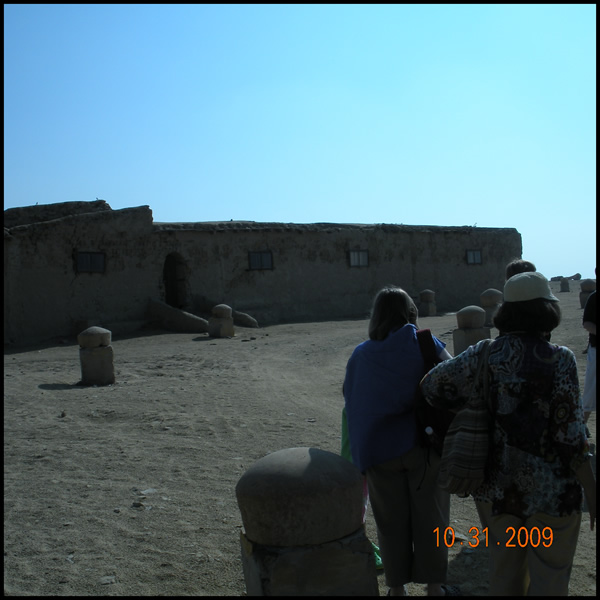 Dr. Wendrich has been excavating at Karanis for three years and her work follows on work done by a team of archaeologists from the University of Michigan that worked here in the 1930’s. The “dig house” that the University of Michigan team had had built was our first stop on the tour. It was constructed using the same mud brick technology that had been employed here forever and consequently had suffered the same fate as all mud brick. Without yearly maintenance, it had crumbled and dissolved in many places; the roofs had caved in and the walls had buckled. Dr. Wendrich had begun to renovate the building with the intention of turning it into a visitors’ center, complete with an observation deck on one roof. Of course all this takes money and progress is slow.
Dr. Wendrich has been excavating at Karanis for three years and her work follows on work done by a team of archaeologists from the University of Michigan that worked here in the 1930’s. The “dig house” that the University of Michigan team had had built was our first stop on the tour. It was constructed using the same mud brick technology that had been employed here forever and consequently had suffered the same fate as all mud brick. Without yearly maintenance, it had crumbled and dissolved in many places; the roofs had caved in and the walls had buckled. Dr. Wendrich had begun to renovate the building with the intention of turning it into a visitors’ center, complete with an observation deck on one roof. Of course all this takes money and progress is slow.

 The scale of this operation, and the effect on the site was astounding, even eighty years on. We walked to a rise and looked down into a bowl-shaped crater that easily covered several acres of ground. The mud brick and other refuse had been dug out to a depth of at least twenty or thirty feet and the unwanted chunks of masonry and stone rubble had simply been tossed aside in heaps. I asked Bethany at this point whether there were any Islamic ruins on the site and she said no; the site had apparently been abandoned before the arrival of the Arab armies in the seventh century and had not been settled after that. This was a disappointment but I was glad to have had the opportunity to see what sort of effect sebakh removal could have on an archaeological site.
The scale of this operation, and the effect on the site was astounding, even eighty years on. We walked to a rise and looked down into a bowl-shaped crater that easily covered several acres of ground. The mud brick and other refuse had been dug out to a depth of at least twenty or thirty feet and the unwanted chunks of masonry and stone rubble had simply been tossed aside in heaps. I asked Bethany at this point whether there were any Islamic ruins on the site and she said no; the site had apparently been abandoned before the arrival of the Arab armies in the seventh century and had not been settled after that. This was a disappointment but I was glad to have had the opportunity to see what sort of effect sebakh removal could have on an archaeological site. Our tour continued with visits to another smaller temple and several granaries. Granaries were quite numerous in Karanis and excavations of them had revealed an elaborate system of storage and methods of protecting and accounting for what grain belonged to which farmer or landlord. There was a sizable Roman garrison here, at one time, to guard the grain. Part of that building still stood, but like all the other mud brick structures, it was slowly dissolving. Bethany showed us photos taken of the same area by the University of Michigan archaeologists; looking at them, it was clear that many of the structures then extant were simply gone, having decayed due to the effects of wind driven sand and rain. Bethany said that standard practice at Karanis, now, was to re-bury all the excavations performed in a season. Sterile sand is brought in to fill excavation trenches and protect any discoveries from weather damage. If any site is to be excavated further in a subsequent digging season (about four months in length, from August through November), the sterile sand has to be removed first.
Our tour continued with visits to another smaller temple and several granaries. Granaries were quite numerous in Karanis and excavations of them had revealed an elaborate system of storage and methods of protecting and accounting for what grain belonged to which farmer or landlord. There was a sizable Roman garrison here, at one time, to guard the grain. Part of that building still stood, but like all the other mud brick structures, it was slowly dissolving. Bethany showed us photos taken of the same area by the University of Michigan archaeologists; looking at them, it was clear that many of the structures then extant were simply gone, having decayed due to the effects of wind driven sand and rain. Bethany said that standard practice at Karanis, now, was to re-bury all the excavations performed in a season. Sterile sand is brought in to fill excavation trenches and protect any discoveries from weather damage. If any site is to be excavated further in a subsequent digging season (about four months in length, from August through November), the sterile sand has to be removed first.

